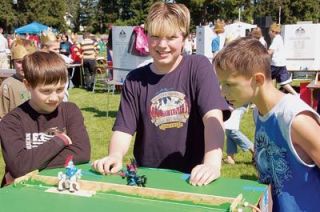MARYSVILLE Marysville Medieval School was the place to be last week, as the entire seventh-grade turned out to demonstrate what life was like in the Middle Ages. The football field morphed into the medieval village green with knights in shining armor, jousting tournaments and catapults flinging stuff high into the air.
At the north end of the field Timothy Martin had a crowd in awe as he launched one projectile after another with his home-built siege weapon.
Its a weapon from the medieval age it would tear down castles, Martin said. I built it to get a good grade and I also thought it would be fun to launch water balloons at my sister afterward.
During a siege a catapult or the more powerful trebuchet would be used to hurl many things at a fortification, such as large stones, sharp wooden poles, casks of burning tar, pots of Greek Fire, dead animals, disease ridden-bodies and quicklime, Martin avidly explained with a disturbing degree of enthusiasm. It took him and his grandfather two days to make the catapult.
It was very fun, I enjoyed making it, Martin said.
The fair involved the entire seventh-grade class and drew hundreds of visitors, including busloads of students from several Marysville elementary schools, including Sunnyside and Liberty. The younger kids got to see the work of the middle schoolers and participate in living lessons about history, technology and society.
Some of the sights to see included many victims of the Black Death with boils and sores on their bodies, explaining just how the bubonic plague was spread and how superstition and a lack of hygiene helped kill more than 25 million people during that era. Other students showed how poor sanitation helped keep people sick and threatened an always precarious food supply.
Brendan Smith built a working joust tournament table, where two miniature horseman would charge each other to dismount opponents from their steed. They were drawn across the green field by wires fed through copper pipes, wound on wooden reels turned by hand. Smiths masterpiece was a big hit as children lined up to play the game in the bright sunshine of May 24.
It was basically their entertainment, Smith explained as his peers Alex Clark and Josh High looked on. It was their form of football.
Clark said that some prisoners or people convicted of crimes could be forced to fight in tournaments, but for the most part it was a mark of distinction and achievement to participate.
It was kind of like how we have professional sports players, Smith explained.
Nearby Peter Finnegan explained how the rigid rules of heraldry and blazonry devices worked much like team colors, to denote who was who on the battle field and even on the street, as marks of class standing.
They had their shields on as their identification, Finnegan said.
Caste and class were also big subjects at the dinner table, according to Jidapa Chinapan, who was cutting little squares of pancakes for visitors to sample. She was dressed as a noble lady and was showing how food was prepared and served. Meals were served much earlier in the day then and were a rigorous display of social divisions, Chinapan said. There was high-table and low-table, the former for the class elite such as royalty, lords, nobles and clergy, the latter for peasants. The fare was much finer for the lords and the peasants got the leftovers. A troupe of players also portrayed the class divisions in a typical dinner of the times where lords and royalty reigned over helpless peasants and women were considered little better than animals.
The food was something else back then, as Sandry Rosales, Mary Woods and Kimmy Davis explained. They had two pies topped with feathers;
They used to have bones and feathers on top so they could tell what was in the pies, Woods explained.
Davis was handing out samples of stained-glass candy, which looked very realistic as she broke off a piece for a visitor. Sugar, spices and other flavorings were rarities and hence, only the elite saw much of them. The food chain back then was very primitive and folks actually scraped the fat from hides as they butchered cattle and tanned leather hides, Rosales explained.
Next door a puppet show asked the age-old question Do you have the plague? That was the Black Death, the great leveler that knew no class distinctions. While Erika Capuli and Brittney Jones worked the sock-puppets, narrator Stephanie Fontanilla explained how pervasive the fear of the bubonic plague were. The old nursery rhyme Ring Around the Rosie contained several allusions to the plague, Fontanilla said. The line ashes, ashes was once a-choo, a-choo, referring to the sneezing of plague victims.
At the other end of the field Neil Hamilton and Zach Perkins had a morbid display of an infant with blackened fingernails and toenails, with a mess pouring out of its torso.
It suffered from the Black Death and we performed surgery on it but it died anyways, Hamilton explained matter-of-factly.
Students spent a couple months on their projects, sewing their own clothes or fashioning their own armor or other devices by hand, according to teacher Susanne Pearson, the trouble-maker-in-chief who spearheaded the effort. She had held similar fairs at schools in California and this was the first at MMS. Liberty, Pinewood and Sunnyside Elementary Schools were invited and Marysville Mayor Dennis Kendall also showed up, Pearson said.
Thats what we wanted, we wanted the community to come in, Pearson said. And we wanted the elementary kids to get excited about middle school.
Medieval students show life in the dark ages
MARYSVILLE Marysville Medieval School was the place to be last week, as the entire seventh-grade turned out to demonstrate what life was like in the Middle Ages. The football field morphed into the medieval village green with knights in shining armor, jousting tournaments and catapults flinging stuff high into the air.



